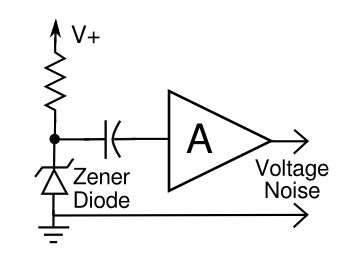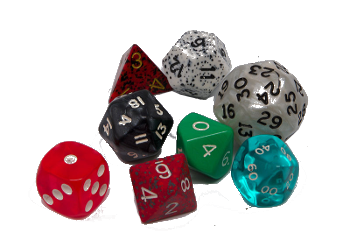Casting Lots in the Digital Age
June 23, 2016
Random numbers are an important part of
computer programming. Aside from their obvious use as a method of throwing "digital
dice" for computer versions of
board games and generating
random play in other
computer games, they're used extensively in
scientific simulations. One of the earliest uses of random numbers in computer simulation was for the
Monte Carlo method, developed principally by
Nicholas Metropolis in the early
1950s.
John von Neumann (1903-1957), a founding figure in
computing, was involved also with the development of the Monte Carlo method. Von Neumann was most concerned that the numbers generated by a computer were as close to random as possible.
Since these "random" numbers are actually produced by an
algorithm, they aren't really random, just
pseudorandom. Von Neumann cautioned against taking the pseudorandom character of these numbers too lightly when he said, "
Any one who considers arithmetical methods of producing random digits is, of course, in a state of sin."[1]
Von Neumann advanced pseudorandom number generation in two ways. First, he
invented the
middle-square method, a rapid generator suitable for simple applications.[1] An example of this method for generating four
digit random numbers follows:
• Select a four-digit "seed" number: 5678
• Square the number: 32239684
• Pad the number to the left with zeros if it's less than eight digits.
• Select the middle four digits: 2396
• This is our first random number, and the seed for the next random number.
In
spreadsheet programs, such as
Gnumeric, you can select the middle digits of a number
n using the
modulus and
integer functions; i.e., =mod(int(n/100),10000). Spreadsheets have their own random function, which is better to use. The first few subsequent numbers generated in the above example are 7408, 8784, 1586, 5153, 5534, 6251, 750, 5625, 6406, and 368. There are two problems with von Neumann's middle-square method. If the middle digits become all zeros, subsequent output is always zero. The generator can also enter a
mode that outputs the same short
sequence, again, and again.
Von Neumann further created a process to extract a greater degree of randomness from a
biased coin toss. Since there are two states (head/tail) in a coin toss, this
Von Neumann Whitening is simply applied to a
bitstream of ones and zeros. The method takes two successive bits at a time, and maps them to a random stream as follows: (0,1) → 0, (1,0) → 1, (0,0) → NULL, (1,1) → NULL, the
NULL meaning that the result is ignored, and you move on to the next two bits of input data. As can be seen in the example below of a bitstream slightly biased to 1, this method discards a lot of bits.

Von Neumann whitening (randomness extractor) applied to a slightly biased random bitstream. (Drawn using Inkscape.)
A simple random bit generator, implemented easily in either
hardware or
software, is the
linear feedback shift register. This is just a
shift register with its input derived from a combination of its contained bits. A 16-bit version having feedback from bits 4, 13, 15, and 16, is shown in the figure. A 32-bit register would have taps at bits 1, 2, 22, and 32, while a 64-bit register would have taps at 60, 61, 63, and 64.

16-bit maximal length (65,535) linear feedback shift register (LFSR) random bit generator. In this example, exclusive-or (XOR) gates are used to effect the feedback function. (Drawn using Inkscape.)
The 16-bit pseudorandom number generator shown above will give you 65,535 bits before repeating, and you can extract as many 16-bit numbers by taking data from the register bits. Another simple random number generator is the
linear congruential generator, a recurrence relation published in 1948 by D.H. Lehmer. I wrote about this generator in an earlier article (One Time Pads, June 12, 2013).
These random number generators can be sufficient for simple simulations, but anything so predictable is not suitable for
cryptography. That's why more advanced pseudorandom number generators, such as the
Mersenne Twister, have been developed.[2] As its name implies, the Mersenne Twister is based on the idea of the
Mersenne primes, and its 32-bit implementation, called MT19937, has a period 2
19937 - 1. It passes the stringent
Diehard suite of
statistical tests for randomness.[3]
Since algorithmic sources of randomness are always problematic, you can look to
nature to give you some
physical sources of randomness. In 1926,
John B. Johnson of
Bell Labs discovered that resistors produce a noise voltage.[4] His Bell Labs
colleague,
Harry Nyquist, was able to explain this
phenomenon, which is now known as
Johnson-Nyquist noise.[5]
This random
voltage noise exists across any
resistor at any
temperature above
absolute zero. Its value is,

where
vn is the
root-mean-square (rms) noise voltage,
kB is the
Boltzmann constant (1.3806 x 10
−23 joule/
kelvin),
R is the
resistance (
ohms),
T is the absolute temperature (kelvin), and
Δf is the
frequency interval over which the noise voltage is measured (
hertz). Since the noise voltage doesn't depend on where the frequency interval is taken, it's
frequency-independent noise; that is, "
white noise."
The
amplitude of Johnson-Nyquist noise is small, so
electrical engineers have found better noise sources. Although the primary purpose of a
Zener diode is to act as a
voltage reference or voltage
limiter, a
reverse-biased Zener diode will produce a noise voltage. A basic
circuit is shown in the figure, and two
amplifiers are usually cascaded to produce volt-level signals. Zener diodes with higher
breakdown voltage produce stronger noise signals.

White noise voltage generator using a reverse-biased Zener diode.
This analog noise can be converted into a digital bitstream using additional circuitry.
(Drawn using Inkscape.)
There are various other ways to generate random signals using
electronics, the technique in ref. 6 being one example.[6] Physical processes that are definitely random, in the sense of "
God playing dice with the world" random, are
quantum processes such as
radioactive decay.[7] I wrote about one method of extracting quantum randomness in an
earlier article (Quantum Random Numbers, September 27, 2010).

If God does play dice with the world, how many faces would his dice have?
Some physicists think the number might be 10 or 11.
(Wikimedia Commons image by Clément Bucco-Lechat.)
Computer scientists are still working to improve random number generation. Recently, computer scientists at the
University of Texas at Austin (Austin, Texas) have
published a method that allows the combination of two data streams of weak randomness into a truly random data stream.[8-9] Their randomness extractor is a huge advance over Von Neumann Whitening, it's not too computationally demanding, and it's won acclaim from other
researchers.[9]
University of Texas at Austin computer science
professor,
David Zuckerman, and his
graduate student,
Eshan Chattopadhyay, have posted a
draft of their work on the
Electronic Colloquium on Computational Complexity, a website similar to
arXiv that allows
authors to post papers for comment before submission to a
journal. Some readers have even extended Zuckerman and Chattopadhyay's original method.[9]
References:
- John von Neumann, “Various techniques used in connection with random digits,” in A.S. Householder, G.E. Forsythe, and H.H. Germond, eds., Monte Carlo Method, National Bureau of Standards Applied Mathematics Series, vol. 12 (Washington, D.C.: U.S. Government Printing Office, 1951): pp. 36-38 (PDF File).
- Geoff Kuenning, "Mersenne Twist Pseudorandom Number Generator Package, 2013.
- Dieharder is a GPL version of Diehard, Robert G. Brown, Dirk Eddelbuettel, and David Bauer, "Dieharder: A Random Number Test Suite," Duke University Web Site.
- J. B. Johnson, "Thermal Agitation of Electricity in Conductors," Phys. Rev., vol. 32 (July 1, 1928), pp. 97ff.
- H. Nyquis, "Thermal Agitation of Electric Charge in Conductors," Phys. Rev., vol. 32 (July 1, 1928), pp. 110ff.
- Willie D. Jones, "Intel Makes a Digital Coin Tosser for Future Processors," IEEE Spectrum Online, June 29, 2010.
- One method is described on the Hot Bits Web Site.
- Eshan Chattopadhyay and David Zuckerman, "Explicit Two-Source Extractors and Resilient Functions," The Electronic Colloquium on Computational Complexity, March 20, 2016.
- New Method of Producing Random Numbers Could Improve Cybersecurity, University of Texas Press Release, May 16, 2016.
Permanent Link to this article
Linked Keywords: Random number generation; random number; computer programming; dice; board game; randomness; random; computer game; science; scientific; computer simulation; Monte Carlo method; Nicholas Metropolis; 1950s; John von Neumann (1903-1957); computing; algorithm; pseudorandom number generator; Any one who considers arithmetical methods of producing random digits is, of course, in a state of sin; invention; invented; middle-square method; numerical digit; random seed; exponentiation; square; data structure alignment; Pad; spreadsheet; computer program; Gnumeric; modulo operation; modulus; floor function; integer; function; mode; sequence; fair coin; biased coin toss; Von Neumann extractor; Von Neumann Whitening; bitstream; Null string; NULL; Inkscape; computer hardware; software; linear feedback shift register; shift register; exclusive-or (XOR) gate; feedback; linear congruential generator; recurrence relation; Derrick Henry Lehmer; cryptography; Mersenne Twister; Mersenne prime; Diehard tests; statistical hypothesis testing; statistical test; nature; physics; physical; John Bertrand Johnson; Bell Labs; colleague; Harry Nyquist; phenomenon; Johnson-Nyquist noise; voltage; resistor; temperature; absolute zero; root-mean-square; Boltzmann constant; joule; kelvin; resistance; ohm; frequency; hertz; independent variable; frequency-independent; white noise; amplitude; electrical engineering; electrical engineer; Zener diode; voltage reference; limiter; reverse-bias; electronic circuit; amplifier; breakdown voltage; analog signal; digital; bitstream; electronics; God does not play dice; quantum mechanics; radioactive decay; dice; physicist; M-theory dimensions; Wikimedia Commons; Clément Bucco-Lechat; computer scientist; University of Texas at Austin (Austin, Texas); scientific literature; publish; research; professor; David Zuckerman; postgraduate education; graduate student; Eshan Chattopadhyay; draft document; Electronic Colloquium on Computational Complexity; arXiv; author; journal.